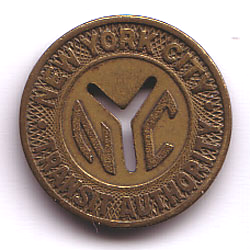A Token Effort
We all know that mass transit involves moving a lot of people from point A to point B, hopefully quickly and efficiently. Typically, we’re talking about a ride on a train, bus, or even a ferry, but the focus of the transit agencies can’t be limited to what happens after you board the vehicle or ship. Processing payments and getting people through the turnstile also needs to be done quickly and efficiently — a long line to pay your fare defeats much of the purpose of a rapid route from home to work or vice-versa.
Over the last few decades, we’ve seen significant changes in how transit agencies handle this process. Some still issue paper tickets. Others use swipe cards, while even more technology-advanced transit systems use contactless cards. Very few still use tokens. And thankfully, no one uses chili powder anymore.
No, you can’t buy a subway ride with spices — at least not in New York City. And no, you never could, either. But for a very long time, subway tokens like the one seen below were the price of entry.

In recent years, those have given way to the MetroCard, seen here. But for generations of commuters, tokens were a part of everyday life. You’d buy the special coin, drop it in a slot next to the turnstile, and make your way through to board your train. It was a pretty straightforward process — unless the slot was jammed up.
In that case, something frustrating happened: your coin would go in just far enough where you couldn’t pull it back out, but not quite far enough to register that you paid. You’d need to use another token at a different turnstile to get to wherever you were ultimately going. But as it turns out, the transit authority wasn’t making money off these broken machines — it, like you, was the victim of a scam.
Somehow — and we’re best off not thinking too hard about how, exactly — someone realized that if you really, really wanted to get a stuck token out of a jammed turnstile slot, you could. All you needed was a vacuum or some other way to suck it out. And while human beings don’t typically come with vacuum attachments, we do some with mouths. Scam artists were intentionally jamming up the works, waiting for commuters to drop a few tokens in, and then sucking up the bounty. Disgusting, yes; profitable, well, it depends how good your health insurance is.
Finding a way to stop this behavior proved tricky, especially because the built-in disincentive to engage in it was pretty huge, but these token suckers weren’t put off by those health implications. And that’s where the chili powder (and Mace) came in. The New York Times explains:
During a typical summer week [in 1989], repair crews were sent on 1,779 calls to fix turnstiles in a system that had 2,897 turnstiles in all. More than 60 percent of the calls involved paper stuffed into the token slots [and many by would-be token suckers].
Occasionally, methods other than incarceration were employed to dissuade the suckers. Token booth clerks were known to sprinkle chili powder into the token slots most often jammed. Some officers resorted to spraying a small amount of Mace around the regular slots and keeping an eye out for the usual suspects. The ones with bright red lips were then arrested.
The move to MetroCards and the deprecation of the token ended the practice — and the need for booby trapping slots. So you probably won’t find yourself covered in chili powder if you take the subway today. And ultimately, the chili powder may not have been necessary. As one officer told the Times, token suckers “had a lot of various diseases. You name it, they had it. You don’t last too long in that line of work.”
Bonus fact: Subway tokens aren’t the only depreciated tokens out there — there are also telephone tokens. In some areas, to make a call on a (similarly rare nowadays) pay phone, one needed to first purchase a special coin which could only be used in the public telephones. Israel, for example, had one called an “asimon” which, as seen here, had the word “telephone” written in Hebrew and Arabic on one side and a depiction of a rotary dial on the other. The coin was last minted in 1982, although still used for a few years after.
From the Archives: The President’s Secret Train Station: It runs under Manhattan, but you can’t enter — with or without a token.
Take the Quiz: How well do you know New York City?
Related: Subway token-inspired jewelry and while we’re at it, asimon-themed cufflinks.
